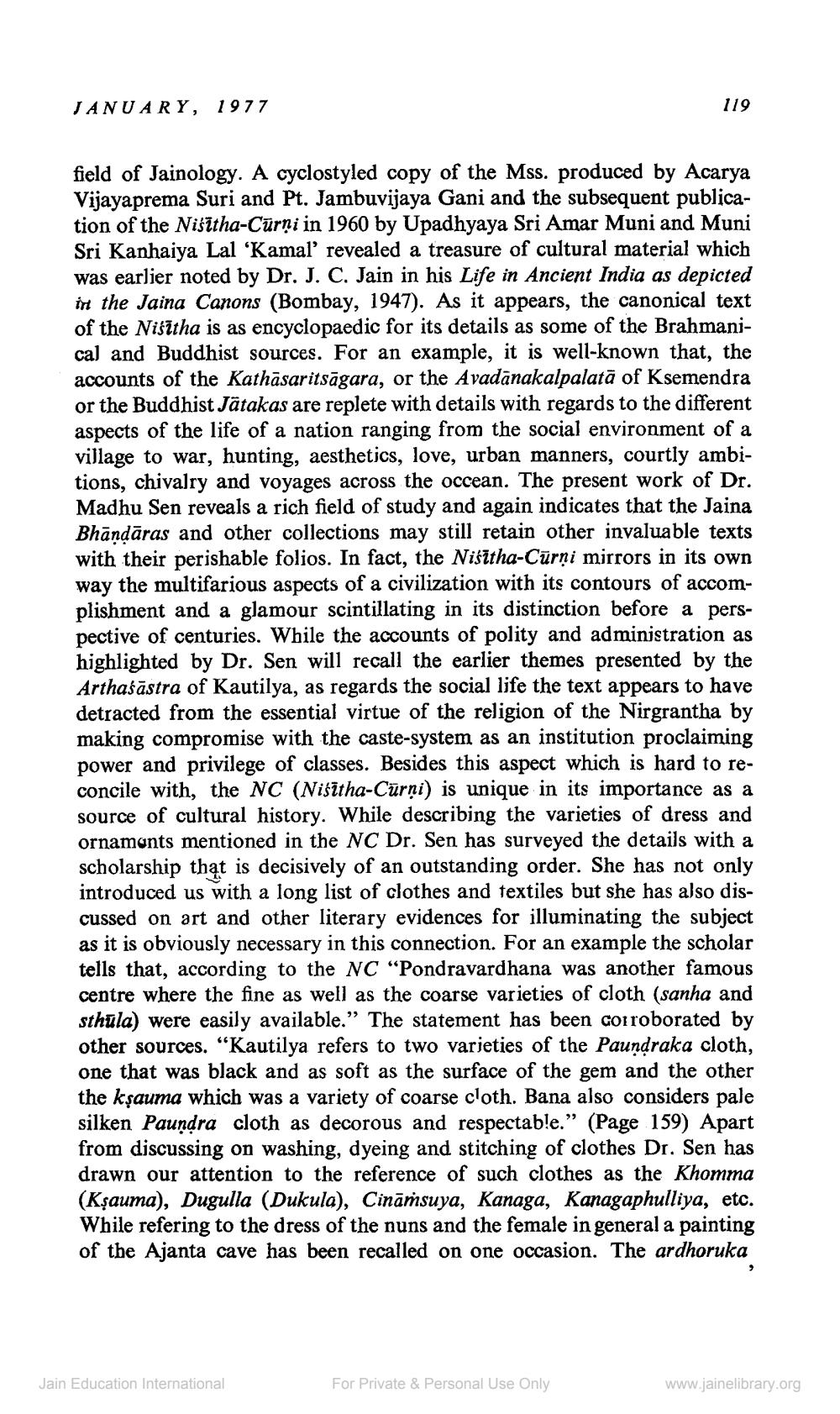Book Title: Jain Journal 1977 01 Author(s): Jain Bhawan Publication Publisher: Jain Bhawan Publication View full book textPage 8
________________ JANUARY, 1977 field of Jainology. A cyclostyled copy of the Mss. produced by Acarya Vijayaprema Suri and Pt. Jambuvijaya Gani and the subsequent publication of the Nisitha-Curni in 1960 by Upadhyaya Sri Amar Muni and Muni Sri Kanhaiya Lal 'Kamal' revealed a treasure of cultural material which was earlier noted by Dr. J. C. Jain in his Life in Ancient India as depicted in the Jaina Canons (Bombay, 1947). As it appears, the canonical text of the Nisitha is as encyclopaedic for its details as some of the Brahmanical and Buddhist sources. For an example, it is well-known that, the accounts of the Kathasaritsagara, or the Avadanakalpalata of Ksemendra or the Buddhist Jätakas are replete with details with regards to the different aspects of the life of a nation ranging from the social environment of a village to war, hunting, aesthetics, love, urban manners, courtly ambitions, chivalry and voyages across the occean. The present work of Dr. Madhu Sen reveals a rich field of study and again indicates that the Jaina Bhāndāras and other collections may still retain other invaluable texts with their perishable folios. In fact, the Nisitha-Curṇi mirrors in its own way the multifarious aspects of a civilization with its contours of accomplishment and a glamour scintillating in its distinction before a perspective of centuries. While the accounts of polity and administration as highlighted by Dr. Sen will recall the earlier themes presented by the Arthasastra of Kautilya, as regards the social life the text appears to have detracted from the essential virtue of the religion of the Nirgrantha by making compromise with the caste-system as an institution proclaiming power and privilege of classes. Besides this aspect which is hard to reconcile with, the NC (Nisitha-Curņi) is unique in its importance as a source of cultural history. While describing the varieties of dress and ornaments mentioned in the NC Dr. Sen has surveyed the details with a scholarship that is decisively of an outstanding order. She has not only introduced us with a long list of clothes and textiles but she has also discussed on art and other literary evidences for illuminating the subject as it is obviously necessary in this connection. For an example the scholar tells that, according to the NC "Pondravardhana was another famous centre where the fine as well as the coarse varieties of cloth (sanha and sthula) were easily available." The statement has been corroborated by other sources. "Kautilya refers to two varieties of the Pauṇḍraka cloth, one that was black and as soft as the surface of the gem and the other the kṣauma which was a variety of coarse cloth. Bana also considers pale silken Paundra cloth as decorous and respectable." (Page 159) Apart from discussing on washing, dyeing and stitching of clothes Dr. Sen has drawn our attention to the reference of such clothes as the Khomma (Kşauma), Dugulla (Dukula), Cināmsuya, Kanaga, Kanagaphulliya, etc. While refering to the dress of the nuns and the female in general a painting of the Ajanta cave has been recalled on one occasion. The ardhoruka Jain Education International 119 For Private & Personal Use Only www.jainelibrary.orgPage Navigation
1 ... 6 7 8 9 10 11 12 13 14 15 16 17 18 19 20 21 22 23 24 25 26 27 28 29 30 31 32 33 34 35 36 37 38 39 40 41 42 43 44
